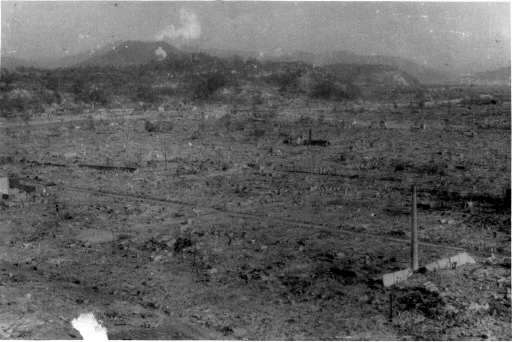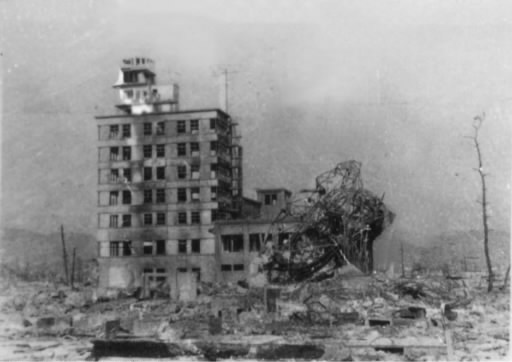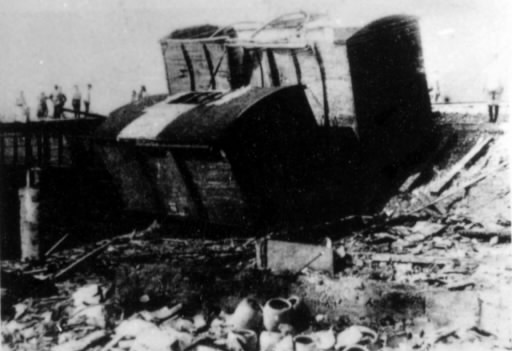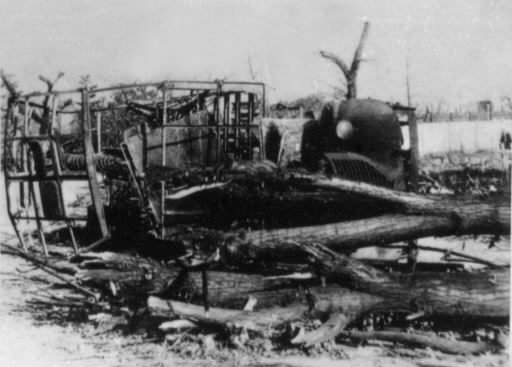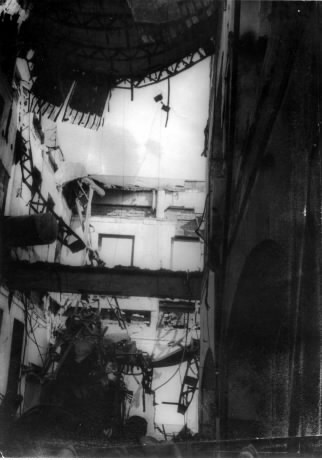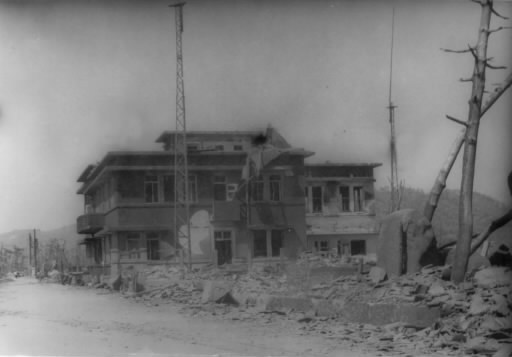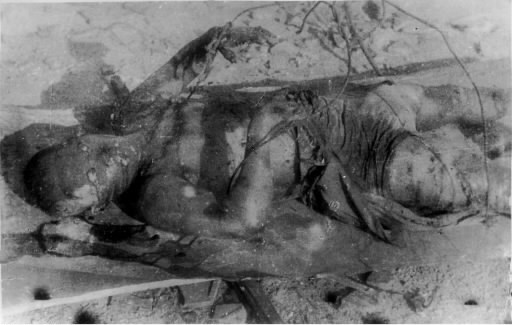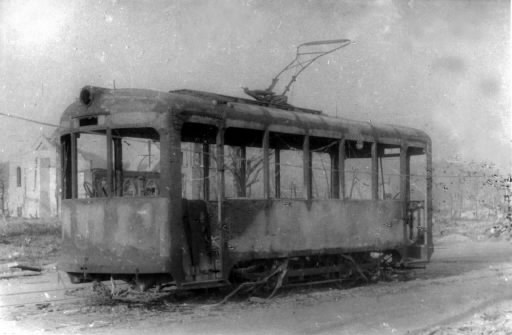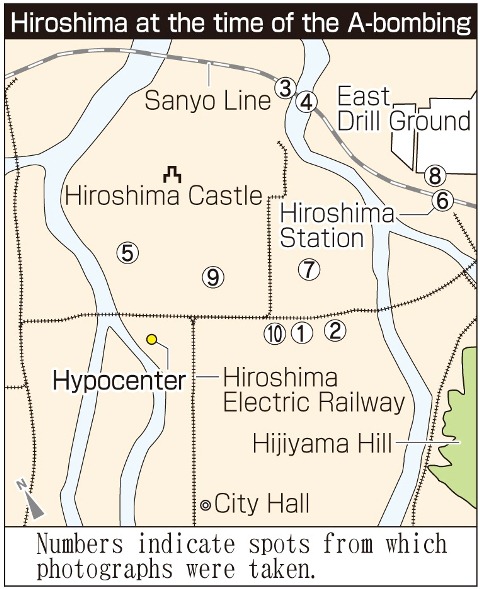- A-bomb Images
- Record of Hiroshima: Forgotten Domei news photos
Record of Hiroshima: Forgotten Domei news photos
by Masami Nishimoto, Senior Staff Writer
The first photos showing the destruction of Hiroshima following the atomic bombing to be distributed nationwide have survived, and information on the photographer and background behind the photos have been discovered. Satsuo Nakata, a photographer for the Osaka bureau of the Domei News Agency, arrived in Hiroshima on August 10, 1945, four days after the A-bombing. The photos taken by Mr. Nakata, who died in 1994 at the age of 74, were published in papers throughout Japan from August 19. Prints of the photos are among the “Aihara materials” kept by the Hiroshima Peace Memorial Museum. (These materials include approximately 6,000 items related to the former Education Ministry’s Scientific Research Council Special Committee for the Investigation of A-bomb Damage.) Thirty-two pictures taken by Mr. Nakata have been found.
Destruction by A-bomb conveyed nationwide
Details have come to light regarding the man who took the first photos of A-bombed Hiroshima to be distributed throughout Japan and the background behind the pictures. Satsuo Nakata (1920-1994), a reporter with the Osaka bureau of the Domei News Agency, came to Hiroshima on August 10, 1945. Thirty-two photos taken by him, including some of the city in ruins, have been found. Of those, at least three were published in various newspapers before the arrival of the U.S. occupation forces, telling of the destruction brought about by the atomic bombing. Under what circumstances were the photos taken and how were they handled? This article traces Mr. Nakata’s footsteps and introduces these forgotten news photos.
The so-called “Aihara materials” inspired this article. Hidetsugu Aihara, 97, a resident of Saitama Prefecture, was a documentary filmmaker who came to Hiroshima in late September 1945 as a member of the Scientific Research Council Special Committee for the Investigation of A-bomb Damage, a government team put together by the former Education Ministry to conduct a comprehensive investigation of the damage done by the A-bomb. The Aihara materials consist of approximately 6,000 photographs and documents collected from that time. Late last year they were sent to the Peace Memorial Museum by the family of Mr. Aihara on his behalf.
The photos of the devastation of Hiroshima and others were found among memos saying, “Domei negatives returned,” “Taken by Nakata” and “I don’t know anything at all about a Mr. Nakata.” There are 32 photos taken by Mr. Nakata.
Established in 1936, the Domei News Agency, a private corporation, was also a news organization under government control. In October 1945, two months after the end of the war, it was dissolved. It was split into the Kyodo News and Jiji Press wire services, but no record of Mr. Nakata’s name or his reporting remains.
Harumi Shoji, 92, a resident of Osaka Prefecture and former photographer for Kyodo News, recalled Mr. Nakata. “He was assigned to the offices of the Osaka Naval Keibitai (guard forces),” Mr. Shoji said. In 1942 Mr. Shoji photographed the meeting between Lt. Gen. Tomoyuki Yamashita and Lt. Gen. Arthur Percival during which the British surrendered Singapore. In 1944 he returned to the news agency’s Osaka bureau and covered stories with Mr. Nakata on several occasions.
Upon examining the photos of Hiroshima taken by Mr. Nakata, Mr. Shoji said, “I’m surprised they survived.” He added, “The images are in focus from the foreground to the background and not grainy. The Leica at our bureau had a range finder. He must have taken it along with him. But I don’t remember him developing and printing these photos at our bureau.” Even if photos were distributed by the Osaka bureau, the negatives were always sent to the paper’s Tokyo headquarters and stored there, Mr. Shoji said.
Following up on the reference to the Osaka Naval Keibitai, I searched for other materials and discovered a memo written by Tsunesaburo Asada (1900-1984), a physics professor at Osaka University, who came to Hiroshima at the request of the navy. The memo referred to “Satsuo Nakata, member of the Domei news team.” A copy is in the Hiroshima Prefectural Archives.
According to the Hiroshima A-bomb Disaster Report by Prof. Asada and his team, Mr. Nakata came to Hiroshima on August 10 as a member of the Osaka Naval Survey Team. The team borrowed a car from the naval hospital in Kure and for two days went around to sites in the vicinity of the hypocenter including Gokoku Shrine, Hatchobori and the East Drill Ground, measuring the radiation. Mr. Nakata is believed to have taken his photographs at that time.
The photo of the devastation taken from the old offices of the Chugoku Shimbun was carried in the August 19 editions of the Asahi Shimbun, the Tokyo and Osaka editions of the Mainichi Shimbun, the Yomiuri Hochi (now the Yomiuri Shimbun) and the Chubu Nihon Shimbun (now the Chunichi Shimbun). Because of restrictions imposed on news outlets by the government and the military, until then the A-bomb had been referred to as a “new type of bomb.” But in the case of Mr. Nakata’s photo it was clearly identified as an “atomic bomb,” and the papers referred to “devastated Hiroshima.” The first photo of the devastation printed by the Chugoku Shimbun was also Mr. Nakata’s shot of the ruins. It was carried in the August 23 edition, which was printed in Kokura (now part of Kitakyushu) because the paper’s headquarters had been destroyed by fire.
Upon pursuing further information on Mr. Nakata, I learned that when the Domei News Agency was dissolved he quit working as a reporter and ran a shop selling imported Western-style clothing and accessories in Osaka. He died in 1994 at the age of 74. His wife died five years later. They had no children, and he apparently made no record of his reporting on the atomic bomb. A niece living in Hyogo Prefecture said, “I heard bits and piece from my uncle about volunteering to go to Hiroshima and taking pictures there, but he never talked about himself much.”
Mr. Nakata, who entered the city in the aftermath of the blast and was thus an A-bomb survivor, died of lung cancer that had metastasized. He never applied for an Atomic Bomb Survivor’s Certificate.
The captions for those of the 32 photographs taken by Mr. Nakata that have been published with this article were written by referring to various documents including memos taken by Mr. Aihara for the survey; verification by Michio Ide (who died in June 2006), a photographer who researched the photos as a member of a group researching materials for the Peace Memorial Museum; notes taken by Tsunesaburo Asada, professor of physics at Osaka University and his Hiroshima A-bomb Disaster Report. All of these materials are in the Hiroshima Prefectural Archives.
Keywords
First news photos of A-bombed Hiroshima
Photos of Hiroshima residents on the day of the atomic bombing were taken by Yoshito Matsushige, a photographer for the Chugoku Shimbun who was serving as a member of the news team of the Chugoku District Military Headquarters. He took five photos. Two shots taken at the Miyuki Bridge, 2.2 km from the hypocenter, were first published in “Evening Edition Hiroshima,” which was issued on July 6, 1946 by the Chugoku Shimbun. Accounts of people involved indicate that the pictures were not published in the paper’s main edition in view of the censorship imposed by the U.S. occupation forces. The negatives of these photos have been preserved.
Because newspapers’ Hiroshima bureaus had been destroyed, reporters came from Osaka to cover the A-bombing. Yukio Kunihira, a member of the photo department of the Mainichi Shimbun’s Osaka office, came to Hiroshima on August 9 with a reporter from the paper’s news department. The Osaka office’s August 11 edition carried two photos with a caption saying, “Hiroshima withstands new-type bomb.” One of the pictures showed canned goods being brought into the Higashi Police Station. The photos were credited to a “member of the National Defense Photographic Team.” According to a publication issued by the Mainichi Shimbun to mark its 130th anniversary, Mr. Kunihira wanted to use photos of burned-out Hiroshima, but military censors did not allow him to do so.
On the evening of August 9, Hajime Miyatake, a member of the photo department of the Asahi Shimbun’s Osaka office, came to Hiroshima as a member of the propaganda team from the army’s Chubu Headquarters in Osaka. The August 16 issue of the paper published by the Osaka office carried a photo of the destroyed Shimomura Jewelers shop (on the Hondori in Naka Ward). Defying a requisition order from the U.S. occupation forces, Mr. Miyatake kept his film, and 121 of his photos remain, including one showing the cremation of dead bodies.
The August 11 edition of the Yomiuri Hochi (now the Yomiuri Shimbun) carried extensive coverage by Ko Shigemitsu, a reporter with the communications department of the paper’s Osaka bureau, who came to Hiroshima on August 8, but it is unclear whether or not he took any photos. The August 14 edition of the Chubu Nihon (Chunichi) Shimbun carried a photo of a collapsed storehouse taken by a special correspondent named Mizuno.
(Originally published on September 24, 2006)
Hiroshima four days after the A-bombing
First photos of the destruction to be distributed nationwide
Pictures taken by Domei photographer
The first photos showing the destruction of Hiroshima following the atomic bombing to be distributed nationwide have survived, and information on the photographer and background behind the photos have been discovered. Satsuo Nakata, a photographer for the Osaka bureau of the Domei News Agency, arrived in Hiroshima on August 10, 1945, four days after the A-bombing. The photos taken by Mr. Nakata, who died in 1994 at the age of 74, were published in papers throughout Japan from August 19. Prints of the photos are among the “Aihara materials” kept by the Hiroshima Peace Memorial Museum. (These materials include approximately 6,000 items related to the former Education Ministry’s Scientific Research Council Special Committee for the Investigation of A-bomb Damage.) Thirty-two pictures taken by Mr. Nakata have been found.
Destruction by A-bomb conveyed nationwide
Details have come to light regarding the man who took the first photos of A-bombed Hiroshima to be distributed throughout Japan and the background behind the pictures. Satsuo Nakata (1920-1994), a reporter with the Osaka bureau of the Domei News Agency, came to Hiroshima on August 10, 1945. Thirty-two photos taken by him, including some of the city in ruins, have been found. Of those, at least three were published in various newspapers before the arrival of the U.S. occupation forces, telling of the destruction brought about by the atomic bombing. Under what circumstances were the photos taken and how were they handled? This article traces Mr. Nakata’s footsteps and introduces these forgotten news photos.
The so-called “Aihara materials” inspired this article. Hidetsugu Aihara, 97, a resident of Saitama Prefecture, was a documentary filmmaker who came to Hiroshima in late September 1945 as a member of the Scientific Research Council Special Committee for the Investigation of A-bomb Damage, a government team put together by the former Education Ministry to conduct a comprehensive investigation of the damage done by the A-bomb. The Aihara materials consist of approximately 6,000 photographs and documents collected from that time. Late last year they were sent to the Peace Memorial Museum by the family of Mr. Aihara on his behalf.
The photos of the devastation of Hiroshima and others were found among memos saying, “Domei negatives returned,” “Taken by Nakata” and “I don’t know anything at all about a Mr. Nakata.” There are 32 photos taken by Mr. Nakata.
Established in 1936, the Domei News Agency, a private corporation, was also a news organization under government control. In October 1945, two months after the end of the war, it was dissolved. It was split into the Kyodo News and Jiji Press wire services, but no record of Mr. Nakata’s name or his reporting remains.
Harumi Shoji, 92, a resident of Osaka Prefecture and former photographer for Kyodo News, recalled Mr. Nakata. “He was assigned to the offices of the Osaka Naval Keibitai (guard forces),” Mr. Shoji said. In 1942 Mr. Shoji photographed the meeting between Lt. Gen. Tomoyuki Yamashita and Lt. Gen. Arthur Percival during which the British surrendered Singapore. In 1944 he returned to the news agency’s Osaka bureau and covered stories with Mr. Nakata on several occasions.
Upon examining the photos of Hiroshima taken by Mr. Nakata, Mr. Shoji said, “I’m surprised they survived.” He added, “The images are in focus from the foreground to the background and not grainy. The Leica at our bureau had a range finder. He must have taken it along with him. But I don’t remember him developing and printing these photos at our bureau.” Even if photos were distributed by the Osaka bureau, the negatives were always sent to the paper’s Tokyo headquarters and stored there, Mr. Shoji said.
Following up on the reference to the Osaka Naval Keibitai, I searched for other materials and discovered a memo written by Tsunesaburo Asada (1900-1984), a physics professor at Osaka University, who came to Hiroshima at the request of the navy. The memo referred to “Satsuo Nakata, member of the Domei news team.” A copy is in the Hiroshima Prefectural Archives.
According to the Hiroshima A-bomb Disaster Report by Prof. Asada and his team, Mr. Nakata came to Hiroshima on August 10 as a member of the Osaka Naval Survey Team. The team borrowed a car from the naval hospital in Kure and for two days went around to sites in the vicinity of the hypocenter including Gokoku Shrine, Hatchobori and the East Drill Ground, measuring the radiation. Mr. Nakata is believed to have taken his photographs at that time.
The photo of the devastation taken from the old offices of the Chugoku Shimbun was carried in the August 19 editions of the Asahi Shimbun, the Tokyo and Osaka editions of the Mainichi Shimbun, the Yomiuri Hochi (now the Yomiuri Shimbun) and the Chubu Nihon Shimbun (now the Chunichi Shimbun). Because of restrictions imposed on news outlets by the government and the military, until then the A-bomb had been referred to as a “new type of bomb.” But in the case of Mr. Nakata’s photo it was clearly identified as an “atomic bomb,” and the papers referred to “devastated Hiroshima.” The first photo of the devastation printed by the Chugoku Shimbun was also Mr. Nakata’s shot of the ruins. It was carried in the August 23 edition, which was printed in Kokura (now part of Kitakyushu) because the paper’s headquarters had been destroyed by fire.
Upon pursuing further information on Mr. Nakata, I learned that when the Domei News Agency was dissolved he quit working as a reporter and ran a shop selling imported Western-style clothing and accessories in Osaka. He died in 1994 at the age of 74. His wife died five years later. They had no children, and he apparently made no record of his reporting on the atomic bomb. A niece living in Hyogo Prefecture said, “I heard bits and piece from my uncle about volunteering to go to Hiroshima and taking pictures there, but he never talked about himself much.”
Mr. Nakata, who entered the city in the aftermath of the blast and was thus an A-bomb survivor, died of lung cancer that had metastasized. He never applied for an Atomic Bomb Survivor’s Certificate.
The captions for those of the 32 photographs taken by Mr. Nakata that have been published with this article were written by referring to various documents including memos taken by Mr. Aihara for the survey; verification by Michio Ide (who died in June 2006), a photographer who researched the photos as a member of a group researching materials for the Peace Memorial Museum; notes taken by Tsunesaburo Asada, professor of physics at Osaka University and his Hiroshima A-bomb Disaster Report. All of these materials are in the Hiroshima Prefectural Archives.
Keywords
First news photos of A-bombed Hiroshima
Photos of Hiroshima residents on the day of the atomic bombing were taken by Yoshito Matsushige, a photographer for the Chugoku Shimbun who was serving as a member of the news team of the Chugoku District Military Headquarters. He took five photos. Two shots taken at the Miyuki Bridge, 2.2 km from the hypocenter, were first published in “Evening Edition Hiroshima,” which was issued on July 6, 1946 by the Chugoku Shimbun. Accounts of people involved indicate that the pictures were not published in the paper’s main edition in view of the censorship imposed by the U.S. occupation forces. The negatives of these photos have been preserved.
Because newspapers’ Hiroshima bureaus had been destroyed, reporters came from Osaka to cover the A-bombing. Yukio Kunihira, a member of the photo department of the Mainichi Shimbun’s Osaka office, came to Hiroshima on August 9 with a reporter from the paper’s news department. The Osaka office’s August 11 edition carried two photos with a caption saying, “Hiroshima withstands new-type bomb.” One of the pictures showed canned goods being brought into the Higashi Police Station. The photos were credited to a “member of the National Defense Photographic Team.” According to a publication issued by the Mainichi Shimbun to mark its 130th anniversary, Mr. Kunihira wanted to use photos of burned-out Hiroshima, but military censors did not allow him to do so.
On the evening of August 9, Hajime Miyatake, a member of the photo department of the Asahi Shimbun’s Osaka office, came to Hiroshima as a member of the propaganda team from the army’s Chubu Headquarters in Osaka. The August 16 issue of the paper published by the Osaka office carried a photo of the destroyed Shimomura Jewelers shop (on the Hondori in Naka Ward). Defying a requisition order from the U.S. occupation forces, Mr. Miyatake kept his film, and 121 of his photos remain, including one showing the cremation of dead bodies.
The August 11 edition of the Yomiuri Hochi (now the Yomiuri Shimbun) carried extensive coverage by Ko Shigemitsu, a reporter with the communications department of the paper’s Osaka bureau, who came to Hiroshima on August 8, but it is unclear whether or not he took any photos. The August 14 edition of the Chubu Nihon (Chunichi) Shimbun carried a photo of a collapsed storehouse taken by a special correspondent named Mizuno.
(Originally published on September 24, 2006)

